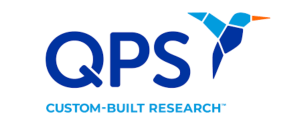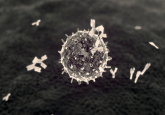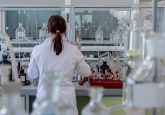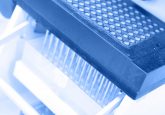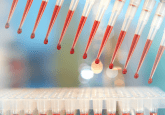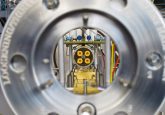The new frontier: ddPCR for cell therapies
In the fourth episode of The New Frontier podcast, we’re joined by Sebastian Guelman, Senior Principal Scientist for Bioanalytical Sciences from Genentech (CA, USA). Sebastian talks about his experience with optimizing ddPCR assays to cell therapy targets and gives us his top tips for ensuring ddPCR assays run smoothly. We discuss his contributions to a recent White Paper and how these publications are integral tools for the bioanalytical community.
Podcast transcript
[00:07] Ellen Williams: Hello, and welcome to the 4th episode of the Bioanalysis Zone podcast on Cell and Gene Therapies sponsored by QPS Holdings. I’m your host, Ellen Williams and today, I’m joined by Sebastian Guelman, Senior Principal Scientist in Bioanalytical Sciences from Genentech. Thank you very much for joining me, Sebastian.
[00:27] Sebastian Guelman: Thank you for having me.
[00:28] Ellen Williams: No problem. For those unfamiliar with your work, your experience is within ddPCR assays to support cell therapy programs. Could you start by explaining how your career path has guided you to the work that you’re doing today?
[00:40] Sebastian Guelman: Sure. Throughout my PhD, I did a lot of biochemistry and molecular biology work and I was constantly thinking about how to improve processes— for instance, increasing the yield in protein expression and purification systems by changing expression vectors and bacterial growth conditions. Another example that comes to mind is designing a PCR-based screening assay for transgenic fruit flies to be more efficient and more high throughput. Then, during my postdoc, I further improved my biochemistry and cell-based assay skills and that led to a job opportunity to work on the development of immunoassays for clinical diagnostics.
That was my first experience contributing to FDA-regulated products. Then, after gaining that valuable experience with immunoassays, I joined a startup, and that startup was developing antibody-drug conjugates to treat solid tumors. My role there was to develop non-clinical pharmacokinetic immunogenicity and cell-based potency assays. That led to my current job at Genentech where I can apply kind of all the expertise that I acquired in my previous positions to develop bioanalytical strategies for different therapeutic modalities. One of those modalities is the T-cell therapy program. For that T-cell therapy program, we use the ddPCR to measure cellular kinetics in blood.
[02:08] Ellen Williams: Great. Thank you. To start us off then, could you explain briefly how ddPCR assays work?
[02:14] Sebastian Guelman: The digital PCR concept relies on the principle of compartmentalization. What this means is that the reaction volume is subdivided into several thousand partitions, so that the DNA amplification reactions occur in each partition. Droplet digital PCR or ddPCR is a subgroup of digital PCR platforms. ddPCR uses oil and a droplet generator to produce around 20,000 nanoliter droplets. ddPCR uses specific primers and a fluorescent probe. After the thermal cycling is complete, the droplet fluorescence is measured with an optical reader.
This enables the identification of the fluorescence-positive and then fluorescence-negative droplets, with the positive droplets consisting of at least one DNA target molecule. Because of the distribution of the target DNA into partitions forward Poisson distribution, based on the ratio of positive to negative droplets, we can calculate the number of target molecules in a reaction. Because of this, ddPCR is a robust and quantitative platform and does not require a standard curve and has increased sensitivity and improved precision compared to qPCR.
[03:36] Ellen Williams: That kind of leads me onto my next question. How do you ensure accuracy and precision in your ddPCR assays in your lab particularly?
[03:44] Sebastian Guelman: Yes. In our group, we develop a wide range of bioanalytical assays to support end-to-end drug development from non-clinical to clinical spaces. We use a variety of assay platforms and that includes the ligand binding assay for PK/ADA measurements and also non-cell-based and cell-based neutralizing antibody assays for ADA characterization. For every bioanalytical assay that we develop, accuracy and precision are key parameters evaluated during assay development. We use that information for the final assay conditions and reagents. So, once the final assay conditions are established, we carry out a thorough qualification process that includes experiments for accuracy, precision, selectivity, dilution linearity and analyte stability.
We want to make sure that all of these parameters meet the acceptance criteria required by the health authorities. For ddPCR-based cellular kinetic assays, since there aren’t any formal guidance from health authorities, the acceptance criteria for accuracy and precision and the acceptance criteria for all the other parameters are based on several White Papers published in recent years. For instance, there’s that paper from Haiyan Ma in 2021 and another one from Amanda Hayes in 2022. This is why I was very happy to join this cross-industry AAPS working group and contribute to the most recent White Paper in the AAPS Journal, where we discuss method development and validation practices for qPCR and dPCR assays in support of cell and gene therapy programs.
[05:29] Ellen Williams: So, after a number of years working in the ddPCR space, are there some tips and tricks that you’ve picked up that have helped some of your methodologies when performing these assays?
[05:39] Sebastian Guelman: Yes. First of all, I always follow the ddPCR vendor’s recommendation on primer probe and design. That includes the primer and probe length, the GC content and the melting temperature. This is described in detail in the assay development section of our manuscript. The first experiment that we usually do is a PCR temperature gradient to figure out the optimal annealing extension temperature. In that experiment, we looked at the condition with the highest fluorescent amplitude difference between the positive and the negative droplets. We also want to make sure we don’t get any nonspecific specific amplification in the negative controls.
Another recommendation is to add a restriction enzyme that does not cut within the amplicon sequence, and that helps reduce viscosity and also distribute the DNA templates into the nano droplets. Because in the cellular kinetics assay we aim for high sensitivity, increasing the DNA input in the ddPCR reaction also helps with assay sensitivity. However, once you reach a certain amount of DNA in the reaction— and this can vary depending on the assay design— once it gets high, the droplet separation will be impacted, and that can lead to inaccurate ddPCR readout. You need to find that sweet spot of DNA input for high sensitivity without compromising the assay performance.
The vendor does not recommend going beyond 1 microgram per reaction. Another trick that helps improve its sensitivity, which has been discussed in a number of conferences and publications, is to run additional sample replicates. For instance, n = 9 or even higher. Then, you can combine or merge the droplet, for instance, information for all the replicas into one well. This merging of multiple wells can overcome the saturation due to high DNA content per well because, in this case, you’re distributing the DNA load across multiple wells. Those are some of my recommendations for assay optimization.
[07:44] Ellen Williams: That’s great. Thank you. Hopefully, that helps somebody listening, someone maybe starting out in ddPCR, so thank you very much for that. You mentioned very briefly earlier on that you contributed to a recent White Paper with numerous other authors. We’ve heard from so many bioanalysts that these White Papers, they’re hugely important for circulating knowledge between labs. Could you maybe talk to me about your experience in putting these papers together and how they’ve been useful to you?
[08:12] Sebastian Guelman: Yes. Contributing to this White Paper was a really great, rewarding experience to me. It was very informative to learn about the many different challenges that different bioanalytical groups around the world encounter and also how they tackle those challenges. And, of course, it’s always great to learn firsthand what works and what doesn’t work in the lab. Also, the working group made me realize the extensive and rich knowledge that scientists [who] work at CROs have because they get to work with multiple sponsors on different therapeutic modalities.
I’m hoping that many bioanalytical labs will find the information we provided very valuable and adopt our proposed assay development and validation practices moving forward. Since this is a relatively new area for the bioanalytical community, continuous knowledge sharing is essential for the scientists to benefit from each other’s work in order to advance new modalities into the clinic.
[09:13] Ellen Williams: Finally, could you maybe share something exciting that you’re doing in your lab currently?
[09:18] Sebastian Guelman: Yes, I think that the overall bioanalytical strategy to support the T-cell therapy program is very exciting because it is very different from the strategy we use to support a traditional biologic, like a monoclonal antibody. I already discussed the ddPCR cellular kinetics assay, but we also developed a multiparameter flow cytometry assay that can measure the persistence of the engineered T-cells in blood. One key advantage of this assay is that it enables immunophenotyping of those engineered T cells. Immunophenotyping of the infused T-cell product is valuable because other groups showed [a] correlation between early memory T-cell phenotypes of the infused product and efficacy.
Another unique aspect of the cell therapy program is the potential for cellular immunogenicity in which the patient’s T-cells could potentially get activated and react against the infused engineered T-cell product. This cellular immune response could potentially impact cellular kinetics, safety and efficacy. For this cellular immunogenicity assay, we collect the peripheral blood mononuclear cells (PBMCs) from the patients at selected time points and then incubate them in the presence of the recombinant receptor, and then we can measure the activation of the T-cells using either flow cytometry or ELISpot.
Also, in addition to the T-cell therapy program, my group supports the bioanalytical work for our personalized mRNA-based neoantigen therapy for cancer. As you know, mRNA-based vaccines and therapeutics are gaining a lot of public interest and recognition after the approval of two very highly effective mRNA-based vaccines for COVID-19. So, for our mRNA-based therapeutic, we developed a plasma mRNA PK assay using the branch DNA platform.
Working with mRNA is challenging and we put a lot of effort into figuring out the best conditions to collect and preserve the clinical samples for mRNA analysis, making sure that we can minimize RNA degradation. This work was published in 2022 in the AAPS Journal. To wrap up, I want to conclude by saying that these new therapeutic modalities make the work of the bioanalytical scientist more challenging, but at the same time more exciting. And I can’t wait to see what the future holds.
[11:46] Ellen Williams: I think you’ve summed that up very, very well. Thank you very much, Sebastian, for joining me on the podcast. It has been lovely to speak to you.
[11:52] Sebastian Guelman: Yes. Thanks a lot, Ellen. I really enjoyed the conversation.
About the speaker:
 Sebastian Guelman
Sebastian Guelman
Senior Principal Scientist, Bioanalytical Sciences
Genentech (CA, USA)
Sebastian Guelman is a Senior Principal Scientist in the BioAnalytical Sciences Department at Genentech. He currently leads the development of bioanalytical strategies to support several cancer immunotherapy programs in Genentech’s pipeline, including new modalities such as T-cell therapy and Individualized Neoantigen-specific Immunotherapy (iNeST). Prior to joining Genentech, Sebastian worked at Iconic Therapeutics (CA, USA), developing pre-clinical pharmacokinetic, immunogenicity and biomarker assays to support an oncology program. Before that, Sebastian worked in the development of immunoassays for clinical diagnostics using different platforms. He received his PhD in Biochemistry and Molecular Biology from the Pennsylvania State University (PA, USA) and was a Post-Doctoral Fellow in the Department of Pathology at Genentech.
![]() Listen to other episodes in this series here.
Listen to other episodes in this series here.
![]() Be the first to hear about the next episode by signing up for email notifications!
Be the first to hear about the next episode by signing up for email notifications!


